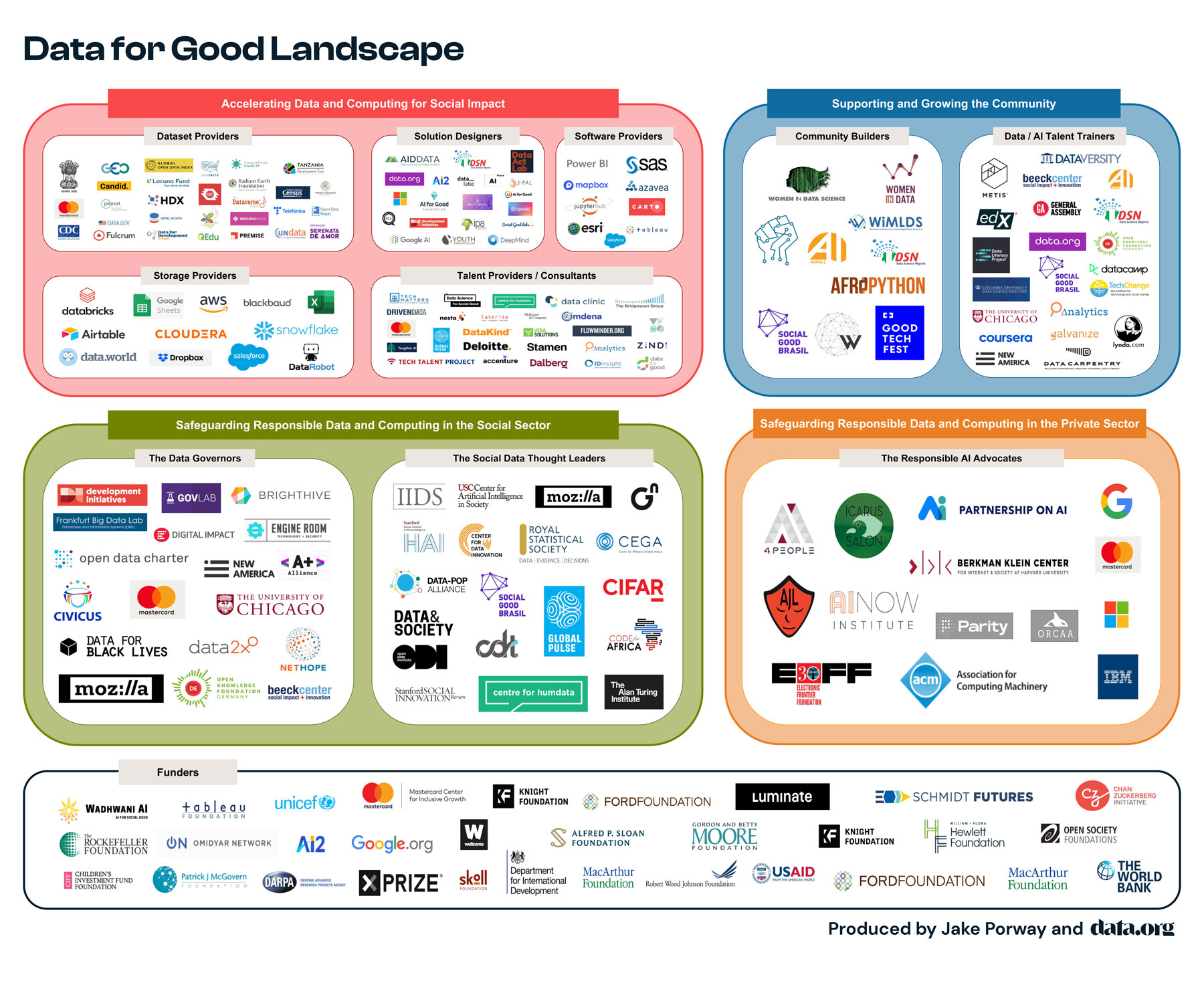Last month we published a look at Charting the Data for Good Landscape that categorized the different efforts under “data for good” and “AI for good”. At that time we mentioned that this project would be evolving, and as we’ve looked at more data and tested better ways of communicating about the different strategies going on in the field, we’ve put together this graphic to help distill our findings. While the last article featured an interactive visualization for understanding the clusters, we found this classic logo map really helped folks understand the state of the space and which initiatives sat where.

About the Author
Jake Porway loves seeing the good values in bad data. As a frustrated corporate data scientist, Porway co-founded DataKind, a nonprofit that harnesses the power of Data Science and AI in the service of humanity by providing pro bono data science services to mission-driven organizations.
Read moreThe most important update in this graphic is the addition of “families” of Data for Good efforts. You’ll recognize the groups from the original Charting the Data for Good Landscape article, but now they’ve been collected and organized by strategy to show some of the territories that exist in the field. We found that there were two dimensions that really determined the overarching mission of a Data for Good initiative:
- Is the initiative’s broad definition of “for good” primarily seeking to accelerate the use of data and computing toward a social problem that does not have enough data and computing applied to it? Or is the initiative primarily seeking to “do good” by safeguarding society from harms that result from applying data and computing to a problem?
- Is the initiative primarily seeking to change the way data and computing is used when it’s built primarily in service of making profits, or when it’s built primarily in service of making social benefit? The difference here is in the leverage points one has available to them to make change.
These two dimensions, discussed in the methodology for creating this landscape, are key to understanding the philosophical outcome of the initiative. We distinguish between changing the way for-profit data solutions are built and not-for-profit data solutions are built because they have different incentive structures and thus different dynamics that affect how much “good” they can be impelled to do. For example, non-profits may have more latitude to slow down the production of a model for predictive policing until it meets the highest ethical standards than a company who has a production schedule to make and a bottom line to achieve.
The result is that we get four major “camps” of folks doing Data for Good – three that try to change the creation of data science in some way, and one that has a cross-cutting goal of improving and nurturing the data science talent pipeline. This fourth group emerged as a prominent faction in the space, though it is separate from the others because it neither explicitly tries to safeguard society or accelerate use of data, opting instead to focus on the health and diversity of the data science talent in the world as a good in and of itself. That leaves us with the four families of Data for Good:
- Accelerating Data and Computing for Social Impact: This family of initiatives focuses on accelerating the use of data and computing toward solving social problems. They deal primarily with data and computing being built in a not-for-profit context, like the data solutions built by nonprofits or governments. You’ll find folks here who increase the supply of data science resources (e.g. The Dataset Providers or Data Talent Providers) as well as those that jump straight to creating more solutions (e.g. the Solution Designers).
- Safeguarding Responsible Data and Computing in the Social Sector: This family seeks to safeguard society from harms that could arise when applying data and computing in not-for-profit contexts. It can be alluring to believe that a nonprofit using data science is “good”, but while their missions may be noble, many harms can arise unintentionally from misuse of data, especially when so much social sector data pertains to vulnerable communities. Data privacy experts, thought leaders on equitable data collection, and explainers of black box algorithms live here in the Data Governors and Social Data Thought Leaders groups.
- Safeguarding Responsible Data and Computing in the Private Sector: Similar to the family above, this set of initiatives seeks to reduce social harms that occur from the misuse of data and computing, though their attention focuses on tech built in the for-profit context. Their best practices may well overlap with those in the social sector, but there are differences in the levers of change they have and the areas they may have the most influence over in the for-profit world. For example, governments and nonprofits, in theory, have a desire to maximize social good with their solutions, so influencing them to change practice is potentially in-line with their goals. For-profit companies may not be so easily impelled to make similar changes should they conflict with profit motives. The Responsible AI faction lives in this corner of the space.
- Supporting and Growing the Community : A number of Data for Good and AI for Good initiatives so label themselves due to their work supporting technologists working in the social sector or for their work creating greater representation in the field of data science and AI. Their strategy is to create a greater abundance of thoughtful, diverse, ethical scientists in the world so that the tools built within any system will be less harmful overall and be applied to more social good problems. Here you’ll find the Data Talent Trainers and Community Builders.
Some other notes about this map:
- As before, this is an alpha version. Version 0.02. A work in progress. We’re putting this work out as it progresses for feedback and reaction, not to say “this is how it is”.
- On that note, the descriptions of strategies and groupings is our own language. Does it align with your understanding of the world? Is your group where you think it should be? What’s missing? Let our lead PI, Jake, know at jake@data.org!
- The Funders have been called out separately from the actors to emphasize their role in funding the space writ large.
- Not every logo is on this figure, of course, but we would like you to tell us which important ones are missing by adding them through this Google form. We’ve been adding the orgs you’re sending us, but we’re backlogged so apologies if your logo didn’t make it into this version!
- The global representation is a little skewed here. We’ve been incorporating folks’ input and let’s just say we have some very active folks filling out the map from Nepal, Brazil, and Nigeria. If you feel your area is underrepresented, jump on in by adding some organizations with this form!
Thanks for staying up to date with this project. We hope this tool ultimately serves as a useful way to understand the different activities in the “Data for Good” and “AI for Good” spaces and as a way to find fellow compatriots within it to partner with, learn from, or fund.
About the Author
Jake Porway loves seeing the good values in bad data. As a frustrated corporate data scientist, Porway co-founded DataKind, a nonprofit that harnesses the power of Data Science and AI in the service of humanity by providing pro bono data science services to mission-driven organizations.
Read moredata.org In Your Inbox
Do you like this post?
Sign up for our newsletter and we’ll send you more content like this every month.
By submitting your information and clicking “Submit”, you agree to the data.org Privacy Policy and Terms and Conditions, and to receive email communications from data.org.
